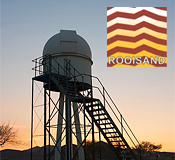 |
ROOISAND OBSERVATORY DeepSky | SITEMAP HOME ROOISAND |
|
 |
|||
| « back to overview Nebulae | Load higher resolution (1700 x 1300 Pixel) | Object description |
The Orion Nebula, M 42, is the brightest star forming region visible from Europe and can already be seen with the naked eye during a dark night in the sword region just below Orion's belt. The nebula's distance is about 1350 light years and its diameter is 25 light years. The brighter central part visible here shows the 4 inner light years of the nebula. M 42 is an active star forming region. About 700 objects have been discovered, covering all development stages of stars.
The nebula is excited to light by a group of 4 young and hot stars in the center. They are also known under the name Trapeze because of their geometric alignment. Besides the shining gas and absorbing dust masses the picture shows a variety of additional smaller objects.
Some of the star-like objects in the nebula are actually gas and dust disks giving birth to new stars. These disks are also called protoplanetary disks (proplyds) because they are the proto clouds for current or future planet creations. The proplyds are being illuminated by the surrounding stars, or become apparent as dark dust disks in front of the bright nebula in the background.
 |
With
the help of the enormous resolution of the Hubble telescope these disks could
be made visible within a star forming region for the very first time and show
an impressive variety of shapes depending on the surrounding radiation
conditions. The labeled version shows the Hubble pictures of all recognizable
proplyds in the same scale. The only exception is the top picture which had to
be downscaled to 50% because of its size. Young stars which just have been born within a dusk disk, create jet-like matter emissions along their rotation axis. These jets strike the surrounding nebula matter and create blazing shock fronts which are also known as Herbig-Haro objects. The recognizable objects in the pictures have been labeled with their Herbig-Haro number (HH xxx). « Load a big labeled picture. |
 |
 |
 |
 |
 |
| Moon | Solar System | DeepSky | Widefield | Miscellaneous |